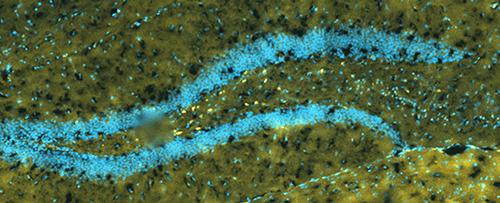Today, few people can claim that stroke has not affected someone in their lives – a friend or family member, mother, or child. Within my family, both my grandmother and my aunt fought and survived stroke. But many are less fortunate, and again this year an estimated 800,000 individuals in the United States will suffer from a stroke.
Though internationally there are currently almost 300 ongoing clinical trials for the development of stroke therapies, there remains only one FDA-approved acute stroke pharmacotherapeutic treatment in the U.S. It is this profound need for both an improved understanding of stroke etiology and the subsequent translation into successful clinical therapies that drives my desire to work in the field of stroke research.
 MIRB-labeled B cells (yellow) in the contralateral hippocampus after focal stroke in mice (blue nuclei stained with DAPI).
MIRB-labeled B cells (yellow) in the contralateral hippocampus after focal stroke in mice (blue nuclei stained with DAPI). Preclinical work in my lab focuses on neuroimmune mechanisms that contribute to neurovascular protection from ischemic injury. Exciting recent data from this research suggest a role for adaptive immunity to hypoxia after preconditioning that may be fundamental to neuroprotection following stroke, including a unique, anti-inflammatory B cell phenotype that is induced by prior stroke onset. This work, in a murine model of transient stroke, was the focus of a funded American Heart Association National Scientist Development Grant in 2014. Subsequent data on the mechanistic contribution of B cells to neuroprotection and neuronal plasticity after stroke laid the foundation for an R01/A1 funded in February 2015.
Since arriving at UT Southwestern, I have begun several collaborations to continue clinical research, in addition to the animal studies. Our funded clinical work investigates neuroinflammatory mechanisms in patients with mild cognitive impairment and Alzheimer’s disease. We also use functional imaging to understand plasticity changes during transcranial direct current stimulation-enhanced physical therapy in patients with prior stroke. Finally, we recently began research into the role of neuroinflammation during pediatric traumatic brain injury.
I hope my interdisciplinary approach will result in a better understanding of mechanisms of recovery – and potentially new neurotherapeutics – for diseases that are the leading causes of long-term adult disability in the United States. This combined bench-to-bedside-to-bench approach has already led to the collection of preliminary data in humans that will inform the experimental design of mechanistic studies in mice.